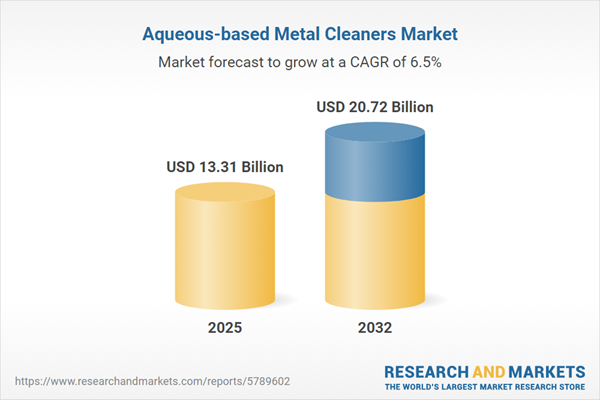Speak directly to the analyst to clarify any post sales queries you may have.
Senior manufacturing leaders are reshaping operational strategies to address rising regulatory complexities and evolving sustainability goals. The aqueous-based metal cleaners market is a pivotal focus, serving as a foundation for efficient compliance and operational performance.
Market Snapshot: Aqueous-Based Metal Cleaners Market
The global aqueous-based metal cleaners market is valued at USD 12.50 billion in 2024 and is projected to reach USD 13.31 billion in 2025, reflecting a compound annual growth rate of 6.52%. Forecasts indicate a market value of USD 20.72 billion by 2032. This growth is being driven by tightening safety regulations and the increasing adoption of green chemistry requirements across priority manufacturing sectors. Automotive, electronics, and industrial manufacturing are leading this evolution, focusing on advanced cleaning processes that reflect new industry standards. Meanwhile, continuous advancements in digital workflow integration and chemical solutions are actively shifting procurement strategies, allowing organizations to strengthen resilience amid changing market demands.
Aqueous-Based Metal Cleaners Market Scope & Segmentation
This report provides senior executives with critical insights into the drivers and emerging opportunities shaping the aqueous-based metal cleaners sector. Key segmentation areas are detailed below, illustrating the breadth of market coverage and relevance to multiple value chains:
- Applications: Degreasing via immersion or spray, ultrasonic cleaning, rust protection, citric and nitric acid passivation, industrial pickling, and solutions tailored to support high-precision processes in manufacturing environments.
- End Use Industries: Aerospace, automotive, electronics, oil and gas, energy storage, and a wide array of manufacturing fields where equipment cleanliness is vital for lifecycle extension and process reliability.
- Metal Types: Ferrous metals such as steel and cast iron, as well as nonferrous options like aluminum and copper, to address varied process and compliance requirements.
- Cleaning Technologies: Immersion equipment, high-efficiency spraying systems, and ultrasonic machinery designed for optimal contaminant removal, supporting consistent product quality on production lines.
- Product Forms: Gels, liquid concentrates, ready-to-use liquids, and powders, each allowing flexible use depending on plant scale, process complexity, and supply chain needs.
- Distribution Channels: OEM supply paths, aftermarket service providers, and digital procurement platforms, helping deliver continuous product access for uninterrupted manufacturing activities.
- Regions Covered: Americas, Europe, Middle East & Africa, and Asia-Pacific, each shaped by distinct compliance frameworks and varying levels of technology adoption and focus.
- Company Analysis: Profiles leading solutions providers including Ecolab Inc., Diversey, Solvay S.A., BASF SE, Dow Inc., Element Solutions Inc., Arkema S.A., Nouryon Holding B.V., Stepan Company, and Henkel AG & Co. KGaA, taking a close look at best practices and overall market influence.
Key Takeaways for Aqueous-Based Metal Cleaners
- Regulatory and environmental priorities are reshaping purchasing and operational decisions, prompting executives to favor solutions supporting responsible manufacturing practices.
- Adoption of expanded automation and integration of ultrasonic technologies is driving greater process efficiency, reliable performance, and scaling to meet shifting production targets.
- Closed-loop systems and enhanced resource management are increasingly applied to align sustainability targets with compliance requirements and waste reduction efforts.
- Region-specific trends highlight early adoption of new cleaning chemistries in Asia-Pacific, while markets in Europe and the Middle East pay greater attention to extending equipment service life and maintaining competitiveness.
- More robust digital procurement and sourcing strategies are central to building supply chain continuity and supporting uninterrupted manufacturing operations.
Tariff Impact on Supply Chain and Sourcing
Recent tariff adjustments in the United States have contributed to higher input costs for specialty surfactants and regenerants essential to aqueous-based metal cleaner formulations. To manage these pressures, organizations are diversifying supplier networks, seeking alternative international partnerships, and strengthening their internal production capabilities. These strategies are focused on managing costs, improving supply stability, and ensuring continued access to critical inputs despite changing trade dynamics.
Methodology & Data Sources
The findings in this report originate from comprehensive analysis of sector data, regulatory sources, peer-reviewed research, and interviews with senior manufacturing executives. Every conclusion is validated through a stringent, multi-stage process to deliver accuracy and actionable insight for executive decision-making.
Why This Report Matters: Aqueous-Based Metal Cleaners
- Delivers practical benchmarks for evaluating sustainability initiatives and navigating evolving regulatory frameworks in industrial cleaning.
- Clarifies how digital transformation and automation enable efficient resource management and streamline critical cleaning operations.
- Empowers leaders with strategies for managing risk and anticipating supply chain disruptions in an increasingly complex manufacturing landscape.
Conclusion
Senior executives can draw on these insights to optimize cleaning strategies, strengthen regulatory alignment, and advance organizational resilience for sustained business growth.
Additional Product Information:
- Purchase of this report includes 1 year online access with quarterly updates.
- This report can be updated on request. Please contact our Customer Experience team using the Ask a Question widget on our website.
Table of Contents
3. Executive Summary
4. Market Overview
7. Cumulative Impact of Artificial Intelligence 2025
Companies Mentioned
The companies profiled in this Aqueous-based Metal Cleaners market report include:- Ecolab Inc.
- Diversey, Inc.
- Solvay S.A.
- BASF SE
- Dow Inc.
- Element Solutions Inc.
- Arkema S.A.
- Nouryon Holding B.V.
- Stepan Company
- Henkel AG & Co. KGaA
Table Information
| Report Attribute | Details |
|---|---|
| No. of Pages | 187 |
| Published | November 2025 |
| Forecast Period | 2025 - 2032 |
| Estimated Market Value ( USD | $ 13.31 Billion |
| Forecasted Market Value ( USD | $ 20.72 Billion |
| Compound Annual Growth Rate | 6.5% |
| Regions Covered | Global |
| No. of Companies Mentioned | 11 |









